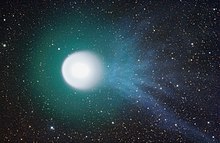Naming of comets
This system, which is still in operation, assigns a code based on the type of orbit and the date of discovery (e.g. C/2012 S1).
Possibly the earliest comet to be named after a person was Caesar's Comet in 44 BC, which was so named because it was observed shortly after the assassination of Julius Caesar and was interpreted as a sign of his deification.
For example, Comet Swift–Tuttle was found first by Lewis Swift and then by Horace Parnell Tuttle a few days later; the discoveries were made independently and so both are honoured in the name.
From the late 20th century onwards, many comets have been discovered by large teams of astronomers, so may be named for the collaboration or instrument they used.
Comet IRAS–Araki–Alcock was discovered independently by a team using the Infrared Astronomy Satellite (IRAS) and the amateur astronomers Genichi Araki and George Alcock.
After their second observed perihelion passage, designations of periodic comets are given an additional prefix number, indicating the order of their discovery.
Interstellar objects are also numbered in order of discovery and can receive names, as well as a systematic designation.
Sometimes it is unclear whether a newly discovered object is a comet or an asteroid (which would receive a minor planet designation).
Any object that was initially misclassified as an asteroid but quickly corrected to a comet incorporates the minor planet designation into the cometary one.
There are only eight such bodies that are cross-listed as both comets and asteroids: 2060 Chiron (95P/Chiron), 4015 Wilson–Harrington (107P/Wilson–Harrington), 7968 Elst–Pizarro (133P/Elst–Pizarro), 60558 Echeclus (174P/Echeclus), 118401 LINEAR (176P/LINEAR), (300163) 2006 VW139 (288P/2006 VW139), (323137) 2003 BM80 (282P/2003 BM80), and (457175) 2008 GO98 (362P/2008 GO98).




